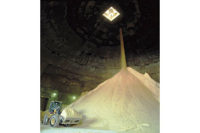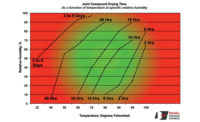What’s in a logo? When it comes to the Gypsum Association (GA) a primary ingredient is history. Founded in 1930, the GA’s mission has remained unchanged. The Association continues to promote the use of gypsum while advancing the development growth, and general welfare of the gypsum industry in the United States and Canada on behalf of its member companies. At the same time, the kind of work the Association engages in on behalf of that mission is very different than it was eight decades ago. Similarly, the range of products our member companies produce has expanded significantly.
Charged with developing a new brand identity, GA staff had to consider both continuity and change because both loom large in a long established organization. The Association could identify only one previous logo and, like the mark in circulation from the 1980s onward, it featured a stack of wallboard and a flame—albeit in a very different design and colorway.
The persistence of the flame makes sense. Fire resistance is a key quality of gypsum, one that is essential to the near universal use of gypsum wallboard as a surface for walls and ceilings. Because gypsum is approximately 21 percent chemically combined water by weight it is an effective fire resistive barrier. When drywall is exposed to fire, the chemically combined water is released as steam, in a process called calcination. As a result, the wood or steel structural members behind the wallboard are protected: The temperature behind the “plane of calcination” remains relatively cool—only slightly higher than the temperature of boiling water (212 degrees Fahrenheit) and significantly lower than the temperature at which steel loses strength or wood ignites.
Because gypsum panels provide a smooth, relatively easy to install surface for walls and ceilings, and because it is used universally, it is easy for the general public to forget how important fire resistance is to its status as the premier building material for wall, ceiling, and partition systems in residential, commercial, and institutional structures. However, within a year of its formation, the GA was conducting fire tests with the National Bureau of Standards, a practice that has become a core competency of the GA and its member companies.
A Growing Family
Developing and providing fire-rated gypsum building systems for use by the design and construction industry continues in full force. The 21st edition of GA-600, Fire Resistance and Sound Control Design Manual, was published in 2015. The Manual has been referenced by the model building codes as a source of fire resistive designs for more than 40 years. Five days a week, architects, specifiers, and construction professionals call the GA’s Technical Services Department with questions, most of which have to do with fire or sound, and many of which can be answered by referencing the GA-600.
Yet, these days, wallboard is just one item in a growing family of gypsum panel products that play an expanded role in building design and construction in both interior and exterior applications. Specialized performance products include mold and moisture resistant gypsum panels, abuse resistant and impact resistant panels and gypsum shaft liner, which makes the construction of area separation fire walls and elevator shafts much more time, labor and cost efficient than masonry construction. All of these products complement the fire resistance inherent to gypsum by engineering in additional attributes that contribute to other aspects of life-cycle performance.
Exterior glass mat gypsum sheathing is one example of these specialized performance gypsum panels. With a noncombustible, moisture-resistant core encased in fiberglass facers on both front and back surfaces and long edges, these gypsum panels are produced by all GA member companies. Cost-efficient and easy to install, fiberglass-faced gypsum sheathing enhances the performance of exterior walls to better resist air and water infiltration, mold growth, noise transmission and flame spread.
Glass mat gypsum panels are applied to the outside surface of wood or steel framing members. These panels serve as an underlayment in exterior wall assemblies clad with any number of materials including brick or stone veneers, stucco, exterior insulation and framing systems, metal panel systems, siding, etc. Featuring mold and moisture resistance as well as fire resistance, these panels are often installed to months before project completion as a means of providing weather protection during construction.
Clearly, gypsum wallboard is not just about interior surfaces anymore—as important as that application scenario continues to be. Meanwhile, consumers of gypsum panel products are not only concerned with product performance but also with the environmental footprint associated with the products they purchase.
Continuity & Change
The demand for life-cycle assessment tools, such as environmental product declarations (EPDs), the existence of a powerful—yet voluntary—green building mandate, the evolution of the building codes in a sustainability-minded direction would all surprise our precursors here at the GA. Nonetheless, both the Association and its member companies have embraced and contributed to the transformation of the building product sector over the course of the last twenty or so years, responding to calls for transparency and sustainability.
To establish industry environmental benchmarking and to encourage the creation of manufacturer-specific sustainability tools, the GA has developed product category rules for regular and type X wallboards as well as exterior glass mat sheathing. From those PCR, ISO 14025 conformance, Type III, cradle-to-shipping gate EPDs for type X and exterior glass mat gypsum panels allow member companies to contribute to points in LEED v4’s “Building product disclosure and optimization—environmental product declarations” credit.
While much of the work the GA does now in support of its member companies would be unimaginable to the Association’s early directors, other forms of engagement would be very familiar indeed. For example, the GA and its members have long been active in ASTM committee C11. Henry J. Schweim, the Association’s first executive and CEO, remains the longest serving secretary of what is now called Committee C11 on Gypsum and Related Building Materials and Systems. However, the fact that the GA and its members devote as much time and attention to committee E60 on Sustainability as they do to C11 would be very surprising to the Association’s founders.
History is change over time. As the Gypsum Association re-evaluated its brand it was tempting to incorporate as many attributes and new products as possible. How could our logo embody our sustainability and product transparency efforts, as well as the GA’s ongoing role in standards development all while highlighting our members expanded range of product offerings? Frankly, our talented designer reminded us, it would be both impossible and outside the capacity of a logo to convey everything about the GA or the products our members manufacture. As we considered the designer’s response, we realized that the Association evolved in response to numerous events, among them the Great Depression, the post-war housing boom, and the emergence of the green building movement—to name just a few. Both the times and other factors, including innovation by member companies, propels the Association and member companies forward, making and remaking our industry, over time.
The new logo, unanimously approved by GA leadership, acknowledges both continuity and change. The key work of the Association is a constant: The GA is the center of expertise on the handling, storage, specification, and proper installation of a rapidly expanding family of gypsum-based sheet products. The 2016 logo retains the flame element, highlighting the established role of fire resistive design assemblies in the building codes. Reflecting the expansion of gypsum panel product offerings, the stack of wallboard depicted in previous iterations of the logo now suggests more: It can be seen as either a series of horizontal boards or as an entire building—recognizing the multiple contributions gypsum panel products make to the built environment.




